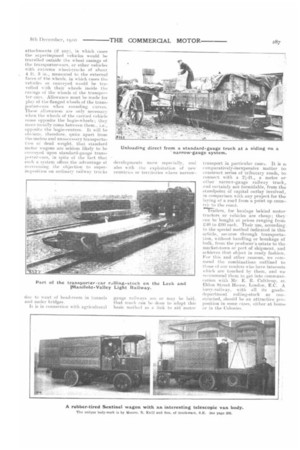Special Transportation Methods.
Page 16

Page 17

If you've noticed an error in this article please click here to report it so we can fix it.
The sulk Conveyance of Loaded Road Vehicles upon Specially-constructed Transporter-cars for Narrow-gauge or Standard Railway Tracks.
(Continued from page 244.)
We promised, in our issue of the .-24th ult., to describe a system which Ave consider to be the best transporter
• ..ear method for cases where conveyance -of the complete vehicle is for any
son found found Do be expedient. Certain _proposals of the kind should command full consideration, in connection with fcounty and other transportation undertakings, for the conveynnee of loaded motor wagons or trailers by rail over straight-away trips of 30 elides and up aids, but only the briefest mention has as yet been made in print of the numerous underlying factors which are embraced by a generic proposition of this character. Mr. Everard It. Calthrop, M.Inst.C.E., 31.I.Mech.E., has given much atteeet-ion to the perfection of transporter:ear plant, and his views were fully econsidered, by a special eommittee of et he Liverpool Incorporated Chamber tof Commerce, which, after extended ieivestigations, reported in the year 1898. The Editor of this journal (as Hon. Sec. of the Liverpool Self-Propelled Traffic Association at that date) rem a member of that special consnnittee, which included representatives elf the Mersey Docks and Harbour 33oard, the Liverpool City Council, the ?Bootle Corporation, the Liverpool Zlorn Trade Association, the Liverpool .4(kitton Association, the Liverpool .Cartowners Association, and of various iirdependent interests. One of the applications of Mr. Calthrop's system is
now in successful operation upon the Leek and Manifold-Valley Light Railnay, by the courtesy of the management of which undertaking we are ahle to reproduce several photographs herewith.
The fundamental principle, it will be observed, is she ready transference of loads, in an unbroken condition, from standard-gauge to narrow-gauge lines, or rice trise. Our illustrations sufficiently convey the details of such an
interchange, and the adaptation of the rolling-stock to suit vehicles fitted with wheels for use on common roads is a matter of obvious simplicity. In fact, the need for exact registration of the rails upon the transporter-car and those upon the permanent way of the main line is obviated.
In all cases where common-road vehicles are to be conveyed upon transporter-cars designed fur Use on narrow-gauge lines, the wheels and wheel casings of the transporter-car lie between the wheels of the vehicle carried by it ; flat channels or troughs, o ithout the grooves which are necessary to take a vehicle with flanged wheels, are employed, and these troughs, owing to their being so close to the ground level, do not appreciably increase the overall height of the load ur raise the centre of gravity ; any simple form of portable incline allows the wagons to be run on or off the carriers, endwise, in any yard, street or siding ; stoutly-built transportercars, for a 2-ft. track, cost not more than 000 each.
It will be elear, on consideration of the unique features which the employment of this system offers, that transehip and terminal services are much reduced. The system, of course, is by no means limited to narrow-gauge railways, although it is most attractive in connection with such projects or undertakings. Transporter-cars, for use an standard-gauge lines, can only take vehicles with inner wheel-tracks of at least 5 ft. 3 in.. measured to the inner faces of the wheels and their
attachments (if any), in whieh (lisps the superimposed vehicle-s would be travelled outside the wheel casings of the transporter-cars, or other vehicles with extreme a heel-tracks of about , 4 ft. 3 in., measured to the external faces of the wheels, in which cases the vehicles so conveyed would he travelled with their a heels inside the casings of the wheels of the transporter cars. Allowance must be made for play of the flanged wheels of the transporter-ears when rounding curves. These allowances are only necessary when the wheels of the carried vehicle come opposite the bogie-wheels ; they more usually come between them., i.e., opposite the bogie-centres. It will be tivious, therefore, quite apart from I he useless and un necessary transportation of dead weight, that standard motor wagons are seldom likely to be conveyed upon standard-gatige transporter-ears, in spite of the fact that such a system offers the advantage ol overcoming the objection to superimposition On ordinary railway trucks
developments more especially, and also with tue exploitat i011 of IleW countries or territories where narrow
transport in particular cases. It is ta comparatively-inexpensive matter to construct series of tributary roads, to connect with a 2,1-ft., a metre or it her narrow-gauge railway track, and certainly not formidable, from the standpoint of capital outlay involved, in comparison with any project for the laying of a road from a point up coun--i-ry to the coast.
"Triailers, for haulage behind motortractors or vehicles are cheap ; they' can be bought at prices ranging from C40 to $.!60 each. Their use, according. to the special method indicated in this article, secures through transportation, without handling or breakage of bulk, from the producer's estate to themarket-town or port of shipment, and achieves that object in ready fashion. For this and other reasons, we commend the combinations outlined to those of our readers who have interests_ Nvhich are touched by them, and we recommend them to get into communi-ration with Mr. E. It. Calthrop, at Eldon Street }loose, London, E.C. A. I orry-railway, with all its goods-department rolling-stock so constructed, should be an attractive proposition in some cases, either at homo or in the Colonies.
























